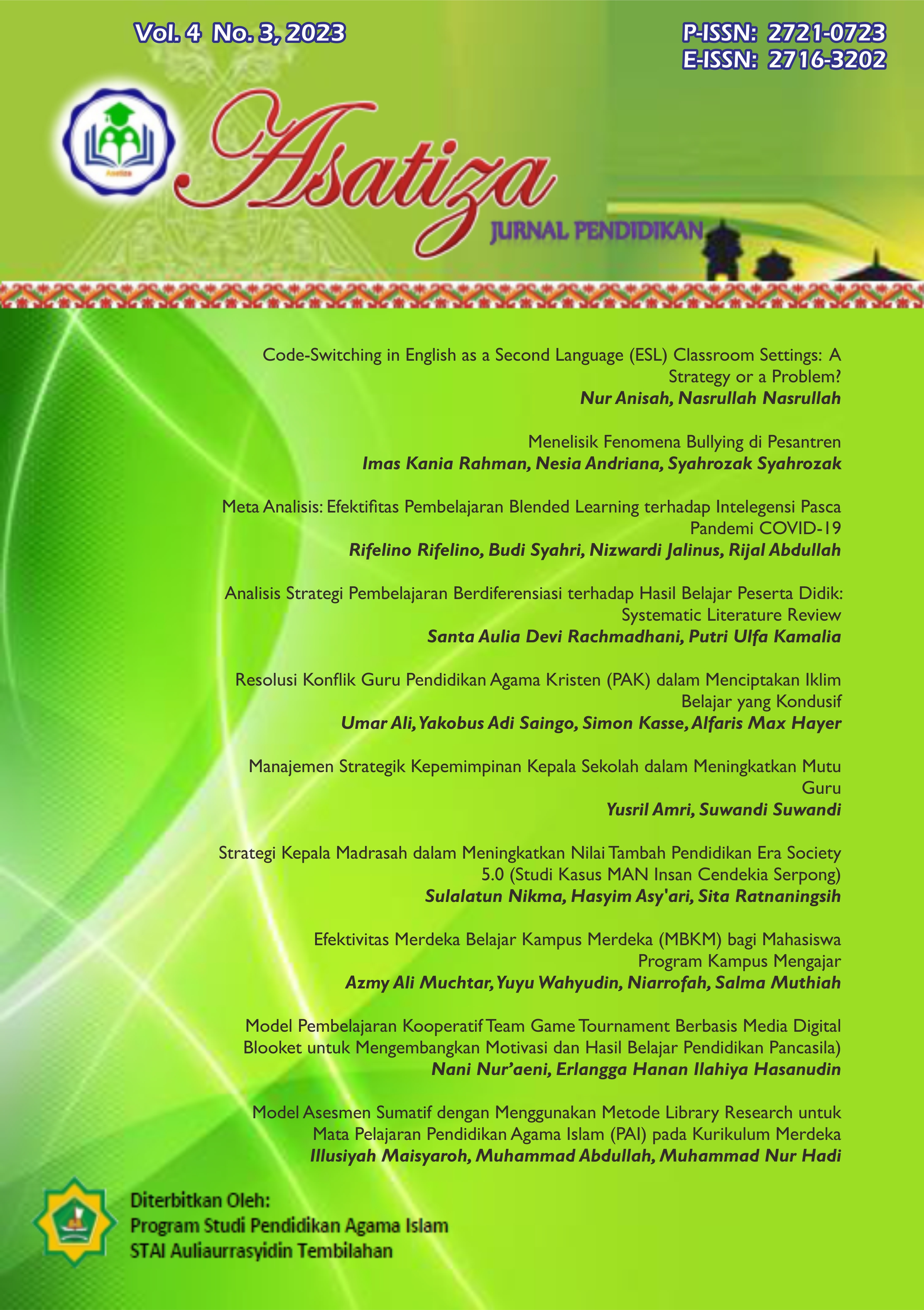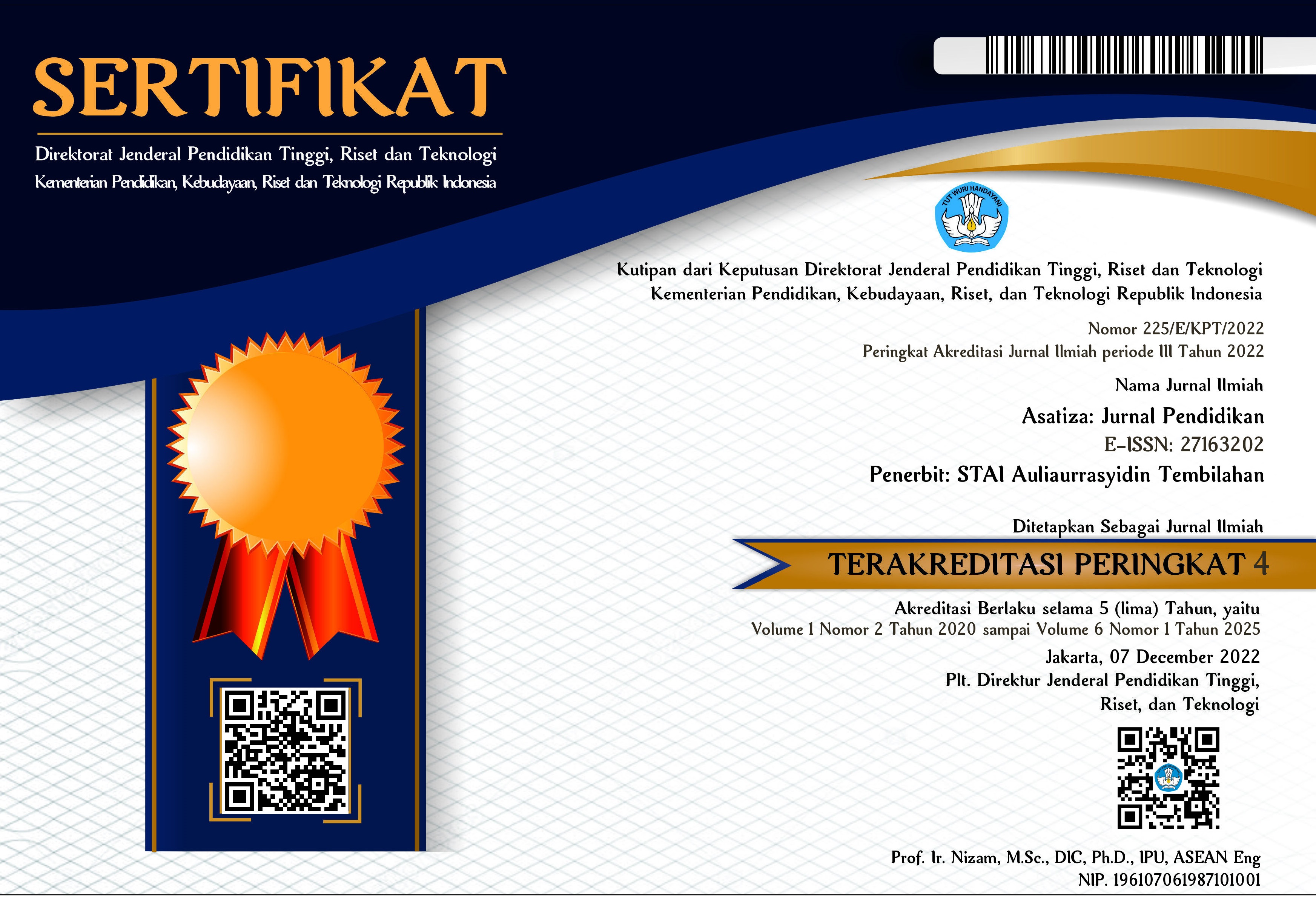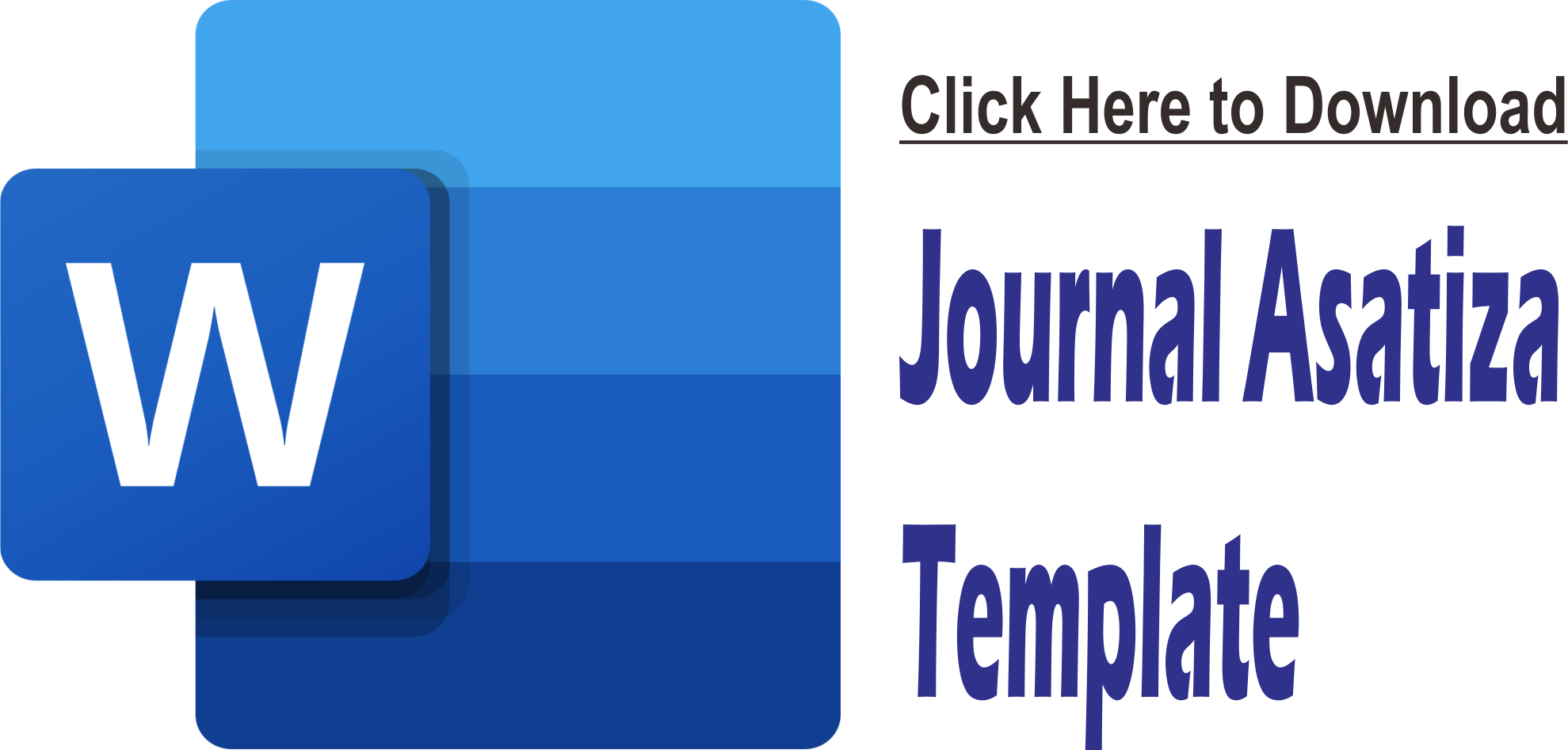Meta Analisis: Efektifitas Pembelajaran Blended Learning terhadap Intelegensi Pasca Pandemi COVID-19
DOI:
https://doi.org/10.46963/asatiza.v4i3.1010Keywords:
Effectiveness, Blended Learning, Intelligence, Size EffectAbstract
The aim of the study is to reveal the effectiveness of blended learning on students' intelligence and behavior during the situation of Covid-19 pandemic. The data source for this type of meta-analyst research analysis comes from 25 articles published in indexed journals. Sampling using purposive sampling technique. The collection of these journals is related to the discussion of blended learning and intelligence after the learning process takes place. Data analysis uses quantitative data by considering the effect size. The results revealed that the application of blended learning contributed to increasing students' intelligence. This is supported by the curiosity of students in utilizing information technology in the learning process.
Downloads
References
Akhmalia, N. L., Suana, W., & Maharta, N. (2018). Efektivitas blended learning berbasis LMS dengan model pembelajaran inkuiri pada materi fluida statis terhadap penguasaan konsep siswa. JIPFRI (Jurnal Inovasi Pendidikan Fisika Dan Riset Ilmiah), 2(2), 56–64. https://doi.org/10.30599/jipfri.v2i2.299
Al-Nasa’h, M., Al-Tarawneh, L., Abu Awwad, F. M., & Ahmad, I. (2021). Estimating students’ online learning satisfaction during COVID-19: A discriminant analysis. Heliyon, 7(12), e08544. https://doi.org/10.1016/J.HELIYON.2021.E08544
Alsarayreh, R. (2020). Using blended learning during COVID-19: The perceptions of school teachers in Jordan. Cypriot Journal of Educational Sciences, 15(6), 1544–1556. https://doi.org/10.18844/cjes.v15i6.5298
Amin, A. K. (2017). Kajian konseptual model pembelajaran blended learning berbasis web untuk meningkatkan hasil belajar dan motivasi belajar. Jurnal Pendidikan Edutama, 4(2), 51–64. http://dx.doi.org/10.30734/jpe.v4i2.55
Bariyah, S. H., & Imania, K. A. N. (2018). Implementasi blended learning berbasis moodle pada jurusan pendidikan teknologi informasi. Jurnal Petik, 4(2), 106–113. https://doi.org/10.31980/jpetik.v4i2.10
Darma, I. K., Karma, I. G. M., & Santiana, I. M. A. (2020). Blended learning, inovasi strategi pembelajaran matematika di era revolusi industri 4.0 bagi pendidikan tinggi. Prosiding Seminar Nasional Pendidikan Matematika, 3, 527–539.
de Brito Lima, F., Lautert, S. L., & Gomes, A. S. (2022). Learner behaviors associated with uses of resources and learning pathways in blended learning scenarios. Computers & Education, 191, 104625. https://doi.org/10.1016/J.COMPEDU.2022.104625
Erdem, D., & Keklik, İ. (2020). Multiple intelligences profiles in prospective teachers. Education Reform Journal, 5(1), 27–44. https://doi.org/10.22596/erj2020.05.01.27.44
Estrada Guillén, M., Monferrer Tirado, D., & Rodríguez Sánchez, A. (2022). The impact of COVID-19 on university students and competences in education for sustainable development: Emotional intelligence, resilience and engagement. Journal of Cleaner Production, 380, 135057. https://doi.org/10.1016/J.JCLEPRO.2022.135057
Haryono, M. A., Asih, A. P., Natoli, L., Ariyani, D., Handayani, D., Agrestryana, N., & Ardiyansyah, A. (2022). Detection and contact tracing of COVID-19 in Indonesia through a Red cross community based surveillance system. International Journal of Infectious Diseases, 116, S35–S36. https://doi.org/10.1016/j.ijid.2021.12.085
Hasanah, H., & Nasir Malik, M. (2020). Blended learning in improving students’ critical thinking and communication skills at University. Cypriot Journal of Educational Sciences, 15(5), 1295–1306. https://doi.org/10.18844/CJES.V15I5.5168
Herlandy, P. B., & Novalia, M. (2019). Penerapan e-learning pada pembelajaran komunikasi dalam jaringan dengan metode blended learning bagi siswa SMK. Journal of Education Informatic Technology and Science, 1(1), 24–33. https://ejurnal.umri.ac.id/index.php/JeITS/article/view/1225
Kim, S. H., & Park, S. (2021). Influence of learning flow and distance e-learning satisfaction on learning outcomes and the moderated mediation effect of social-evaluative anxiety in nursing college students during the COVID-19 pandemic: A cross-sectional study. Nurse Education in Practice, 56, 103197. https://doi.org/10.1016/J.NEPR.2021.103197
Meltem Eryilmaz, A. (2015). The effectiveness of blended learning environments. Contemporary Issues in Education Research (CIER), 8(4), 251–256. https://doi.org/10.19030/CIER.V8I4.9433
Morgan, J. J., & Spies, T. G. (2020). Integrating blended learning in middle school ELA classrooms to support diverse learners: Lessons learned. Journal of School Administration Research and Development, 5(1), 44–51. https://digitalscholarship.unlv.edu/ecs_fac_articles/129
Mufidah, N. L., & Surjanti, J. (2021). Efektivitas model pembelajaran blended learning dalam meningkatkan kemandirian dan hasil belajar peserta didik pada masa pandemi COVID-19. Ekuitas: Jurnal Pendidikan Ekonomi, 9(1), 187. https://doi.org/10.23887/ekuitas.v9i1.34186
Nugraha, D. M. D. P. (2020). Integrasi pendidikan karakter dalam penerapan blended learning di sekolah dasar. Cetta: Jurnal Ilmu Pendidikan, 3(3), 472–484.
Obaid Alrouji, O., & Alrouji, O. (2020). The effectiveness of blended learning in enhancing Saudi students’ competence in paragraph writing. English Language Teaching, 13(9), 72–82. https://doi.org/10.5539/elt.v13n9p72
Octaria, D., Fitriasari, P., & Sari, N. (2020). Blended learning dengan macromedia flash untuk melatih kemandirian belajar mahasiswa. Jurnal Elemen, 6(1), 25–38. https://doi.org/10.29408/jel.v6i1.1596
Qotrunnada, A., Amanto, A., Khasanah, N., & Pekalongan, I. (2021). Blended learning: Solusi model pembelajaran dimasa pandemi COVID-19. Indonesian Journal of Islamic Elementary Education, 1(1), 1–14. https://doi.org/10.28918/IJIEE.V1I1.3909
Rachman, A., Sukrawan, Y., & Rohendi, D. (2019). Penerapan model blended learning dalam peningkatan hasil belajar menggambar objek 2 dimensi. Journal of Mechanical Engineering Education, 6(2), 145–152. https://doi.org/10.17509/jmee.v6i2.21784
Rahmani, A. P. (2022). Penerapan Metode blended learning untuk meningkatkan minat belajar peserta didik selama masa pandemi COVID-19. EduBase : Journal of Basic Education, 3(1), 21–34.
Shirish, A., Chandra, S., & Srivastava, S. C. (2021). Switching to online learning during COVID-19: Theorizing the role of IT mindfulness and techno eustress for facilitating productivity and creativity in student learning. International Journal of Information Management, 61, 102394. https://doi.org/10.1016/J.IJINFOMGT.2021.102394
Sukirman, S., Masduki, Y., Suyono, S., Hidayati, D., Kistoro, H. C. A., & Ru’iya, S. (2022). Effectiveness of blended learning in the new normal era. International Journal of Evaluation and Research in Education (IJERE), 11(2), 628–638. https://doi.org/10.11591/IJERE.V11I2.22017
Sulthoniyah, I., Afianah, V. N., Afifah, K. R., & Lailiyah, S. (2022). Efektivitas model hybrid learning dan blended learning terhadap motivasi belajar siswa sekolah dasar. Jurnal Basicedu, 6(2), 2466–2476. https://doi.org/10.31004/basicedu.v6i2.2379
Surata, I. K., Sudiana, I. M., & Sudirgayasa, I. G. (2020). Meta-analisis media pembelajaran pada pembelajaran biologi. Journal of Education Technology, 4(1), 22–27. https://doi.org/10.23887/JET.V4I1.24079
Syahruddin, S., Yaakob, M. F. M., Rasyad, A., Widodo, A. W., Sukendro, S., Suwardi, S., Lani, A., Sari, L. P., Mansur, M., Razali, R., & Syam, A. (2021). Students’ acceptance to distance learning during Covid-19: the role of geographical areas among Indonesian sports science students. Heliyon, 7(9), e08043. https://doi.org/10.1016/J.HELIYON.2021.E08043
Tong, D. H., Uyen, B. P., & Ngan, L. K. (2022). The effectiveness of blended learning on students’ academic achievement, self-study skills and learning attitudes: A quasi-experiment study in teaching the conventions for coordinates in the plane. Heliyon, 8(12), e12657. https://doi.org/10.1016/j.heliyon.2022.e12657
Tullo, D., Faubert, J., & Bertone, A. (2023). Distinctive patterns of Multiple Object-Tracking performance trajectories in youth with deficits in attention, learning, and intelligence. Research in Developmental Disabilities, 133, 104402. https://doi.org/10.1016/j.ridd.2022.104402
Widiara, I. K. (2018). Blended learning sebagai alternatif pembelajaran di era digital. Purwadita: Jurnal Agama dan Budaya, 2(2), 50–56. https://doi.org/10.55115/purwadita.v2i2.87
Downloads
Published
Issue
Section
License
Copyright (c) 2023 Rifelino Rifelino, Budi Syahri, Nizwardi Jalinus, Rijal Abdullah

This work is licensed under a Creative Commons Attribution-ShareAlike 4.0 International License.
Authors who publish with this journal agree to the following terms:
1. Copyright on any article is retained by the author(s).
2. The author grants the journal, right of first publication with the work simultaneously licensed under a Creative Commons Attribution shareAlike 4.0 International License that allows others to share the work with an acknowledgment of the work’s authorship and initial publication in this journal.
3. Authors are able to enter into separate, additional contractual arrangements for the non-exclusive distribution of the journal’s published version of the work (e.g., post it to an institutional repository or publish it in a book), with an acknowledgment of its initial publication in this journal.
4. Authors are permitted and encouraged to post their work online (e.g., in institutional repositories or on their website) prior to and during the submission process, as it can lead to productive exchanges, as well as earlier and greater citation of published work.
5. The article and any associated published material is distributed under the Creative Commons Attribution-ShareAlike 4.0 International License











2.png)



